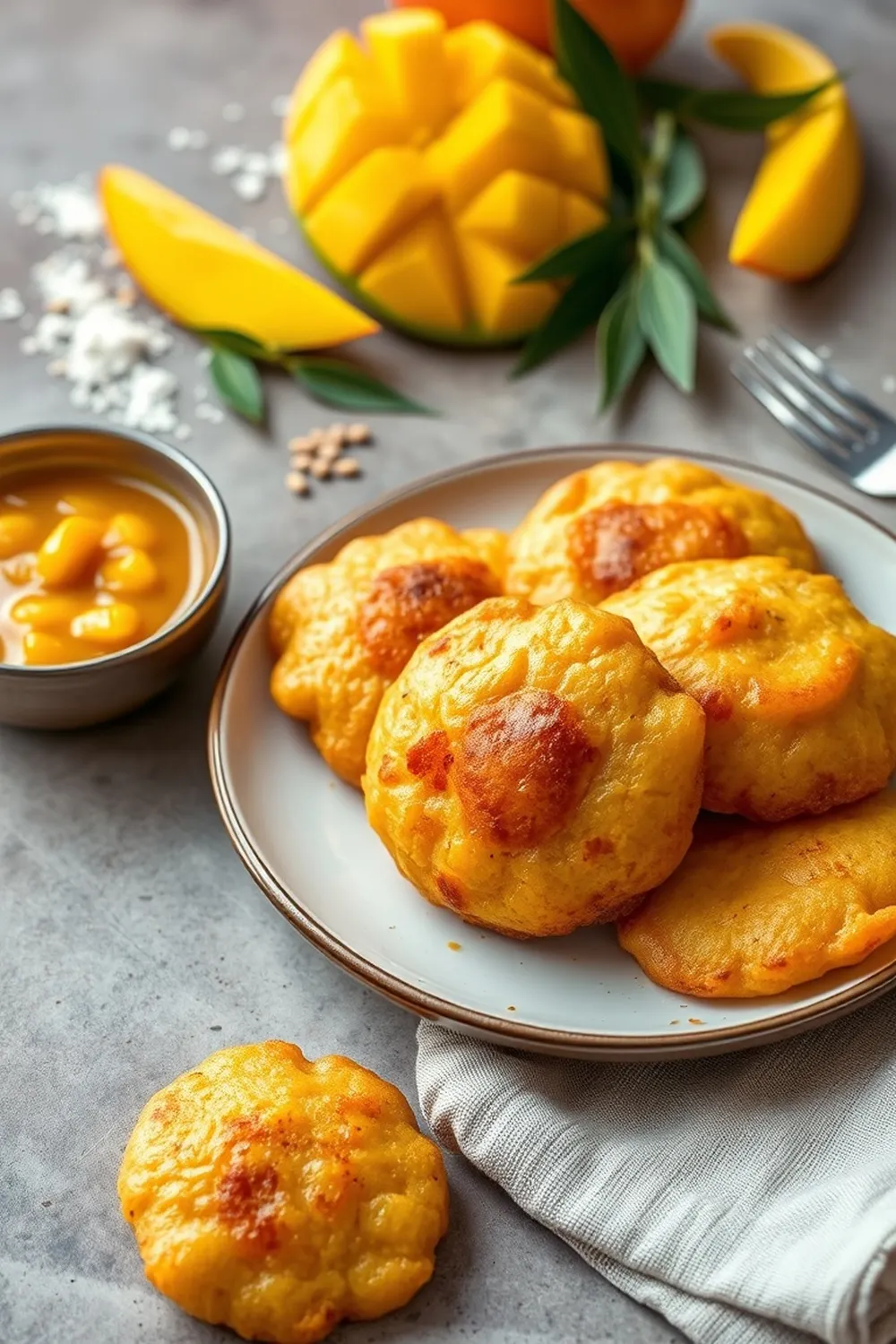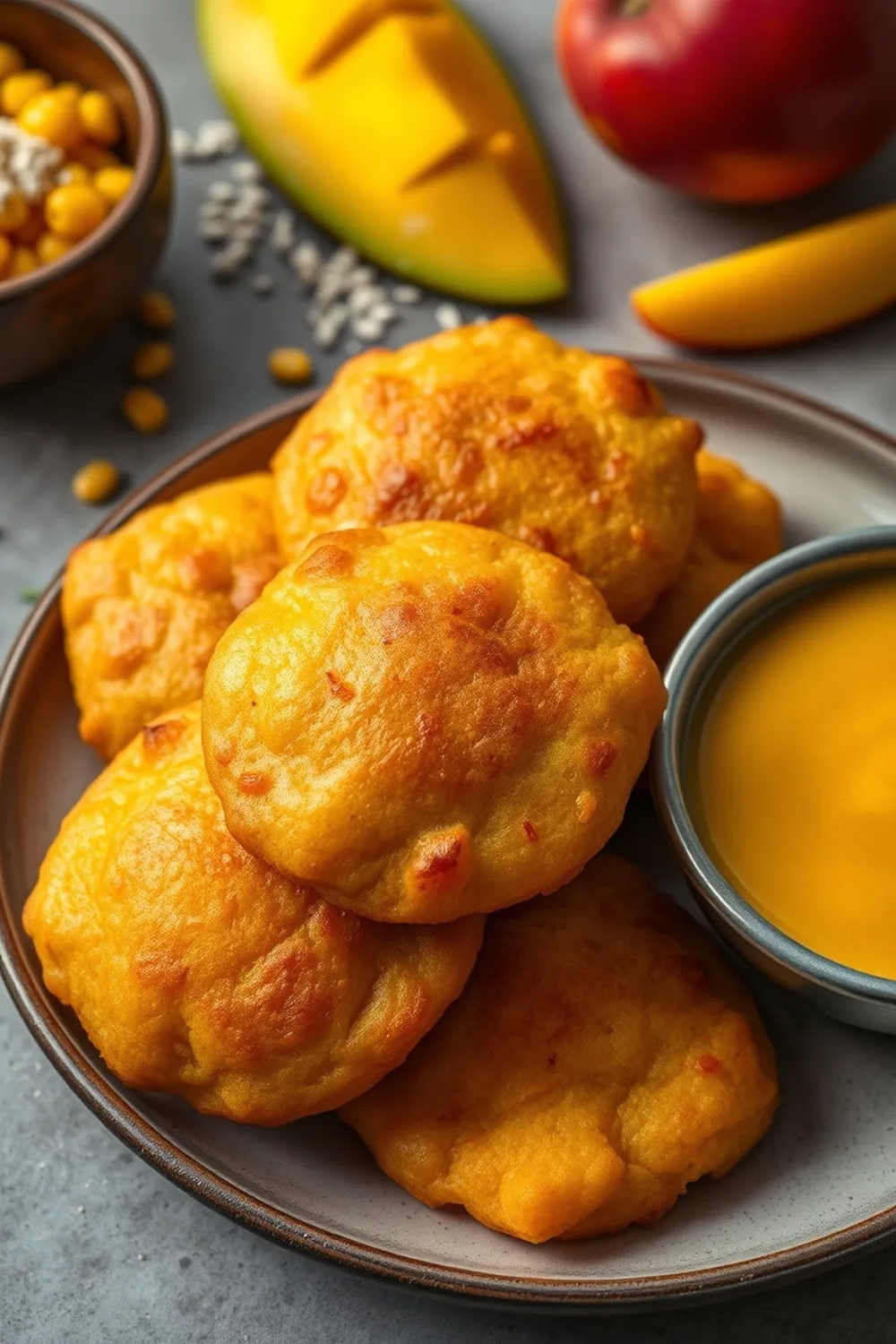- In a mixing bowl, combine wheat flour, mango puree, cardamom powder, and salt.
- Mix the ingredients using your fingertips, gradually adding water until a dough forms.
- Knead the dough until smooth and pliable, then let it rest for 15-20 minutes.
- Divide the dough into small balls, flatten each slightly, and roll into thick circles (about 4-5 inches in diameter).
- Heat oil in a kadai (or deep frying pan) over medium-high heat. Test the oil temperature by dropping a small dough piece; it should rise immediately.
- Fry each poori one at a time, gently pressing with a slotted ladle to puff it up. Cook until golden brown and crisp on both sides.
- Drain excess oil on paper towels and serve the mango poori hot with your favorite gravy or chutney.
- Calories:11 kcal25%
- Energy:46 kJ22%
- Protein:0.2 g28%
- Carbohydrates:3 mg40%
- Sugar:2 mg8%
- Salt:0.2 g25%
- Fat:0.1 g20%
Last Updated on 6 months ago by Neha Deshmukh
Mango Poori Recipe – Authentic Indian Fried Bread with Cardamom
Hey everyone! If you’re anything like me, the smell of freshly fried poori instantly transports you back to childhood. There’s just something so comforting about that warm, fluffy bread. Today, I’m sharing a special version – Mango Poori! It’s a delightful twist on a classic, infused with the sweet, summery goodness of mangoes and a hint of cardamom. Trust me, this one will be a hit!
Why You’ll Love This Recipe
This Mango Poori recipe isn’t just about taste; it’s about creating a little moment of joy. The subtle sweetness of the mango complements the savory wheat flour beautifully. Plus, the cardamom adds a lovely aromatic touch. It’s surprisingly easy to make, even if you’re new to making pooris. And honestly, who can resist a warm, puffed-up poori straight from the kadai?
Ingredients
Here’s what you’ll need to whip up a batch of these golden beauties:
- 1 heaped cup (approximately 150g) wheat flour (atta)
- 1 small mango (about 100-150g pulp)
- ¼ teaspoon (approximately 0.75g) cardamom powder
- Salt to taste (around ¼ teaspoon or 1.5g)
- 3 tablespoons (approximately 45ml) water
Ingredient Notes
Let’s talk ingredients! A few little things can make a big difference.
Mango Selection & Ripeness
You want a mango that’s sweet and fragrant, but not too ripe. Slightly firm mangoes work best – Alphonso, Kesar, or even a good quality Totapuri are fantastic choices. Overripe mangoes can make the dough sticky.
Wheat Flour Type – Atta vs. Maida
Traditionally, pooris are made with whole wheat flour (atta). This gives them a lovely texture and a slightly nutty flavor. You can use maida (all-purpose flour) for a softer, more refined poori, but I personally prefer atta for its health benefits and taste.
Cardamom Powder – Freshly Ground vs. Store-Bought
Freshly ground cardamom is always best! The aroma is incredible. But if you’re short on time, good quality store-bought cardamom powder works just fine. Just make sure it smells fragrant.
Oil for Frying – Regional Preferences & Healthier Options
Traditionally, ghee (clarified butter) is used for frying pooris in many Indian households, especially for festivals. It imparts a wonderful flavor. However, you can absolutely use vegetable oil, sunflower oil, or groundnut oil. I often use sunflower oil for everyday cooking.
Step-By-Step Instructions
Alright, let’s get cooking!
- Combine Dry Ingredients: In a mixing bowl, add the wheat flour, cardamom powder, and salt. Give it a good mix.
- Add Mango Pulp: Now, add the mango puree to the flour mixture.
- Start Mixing: Using your fingertips, start rubbing the mango into the flour. It will seem crumbly at first, that’s okay!
- Add Water Gradually: Slowly add water, a tablespoon at a time, while continuing to mix. The goal is to form a soft, pliable dough.
- Knead the Dough: Once the dough comes together, knead it for about 5-7 minutes until it’s smooth and elastic. This is important for getting those perfect puffs!
- Rest the Dough: Cover the dough with a damp cloth and let it rest for at least 15 minutes. This allows the gluten to relax, making the pooris easier to roll.
- Divide and Roll: Divide the dough into small, equal-sized balls (about the size of a walnut). Flatten each ball slightly, then roll it out into a thick circle – about 4-5 inches in diameter. Don’t worry about making them perfectly round!
- Heat the Oil: Heat oil in a kadai (deep frying pan) over medium-high heat. To test if the oil is hot enough, drop a tiny piece of dough into it. It should sizzle and rise to the surface immediately.
- Fry the Pooris: Gently slide a poori into the hot oil. Using a ladle, gently press down on the poori. This helps it puff up. Fry for about 30-60 seconds per side, until golden brown and crispy.
- Drain and Serve: Remove the poori from the oil and drain it on a paper towel-lined plate. Serve hot with your favorite gravy or side dish!
Expert Tips
A few little secrets to help you nail this recipe:
Achieving the Perfect Puff
The key to a perfectly puffed poori is the right oil temperature and gentle pressure with the ladle. Don’t overcrowd the kadai, fry one poori at a time.
Kneading the Dough – Technique is Key
Kneading develops the gluten, which gives the pooris their structure. A well-kneaded dough will be smooth and elastic.
Oil Temperature Control
If the oil isn’t hot enough, the pooris will absorb too much oil. If it’s too hot, they’ll burn quickly. Medium-high heat is ideal.
Troubleshooting – Pooris Not Puffing Up
Don’t panic! Here are a few reasons why your pooris might not be puffing up:
- Dough is too dry: Add a teaspoon of water at a time and knead again.
- Oil isn’t hot enough: Increase the heat slightly.
- Not enough pressure: Gently press down on the poori with the ladle while frying.
Variations
Want to get creative? Here are a few ideas:
Vegan Mango Poori (Oil & Flour Considerations)
To make this vegan, simply ensure you’re using vegetable oil for frying. The recipe is naturally vegan otherwise!
Gluten-Free Mango Poori (Alternative Flours)
For a gluten-free version, try using a gluten-free atta blend or a mix of rice flour and tapioca starch. You might need to adjust the water quantity.
Spice Level – Adding a Touch of Chili
My friend, Priya, loves to add a pinch of chili powder to the dough for a little kick! Feel free to experiment.
Festival Adaptations – Mango Poori for Special Occasions
During festivals like Holi or Diwali, my family loves to serve Mango Poori with a special chana masala (chickpea curry). It’s a festive treat!
Serving Suggestions
Mango Poori is delicious on its own, but even better with:
- Chana Masala: A classic pairing!
- Aloo Sabzi: Potato curry.
- Dal Makhani: Creamy black lentil dish.
- Raita: Yogurt dip.
Storage Instructions
Mango Poori is best enjoyed fresh. However, you can store leftover pooris in an airtight container at room temperature for up to a day. They will lose some of their crispness, but you can reheat them briefly in a tawa (flat griddle) or oven.
FAQs
Let’s answer some common questions:
What type of mango is best for making poori?
Alphonso, Kesar, or Totapuri mangoes are all great choices. You want a mango that’s sweet and fragrant, but not overly ripe.
Can I make the dough ahead of time?
Yes, you can! Just make the dough, knead it well, and store it in an airtight container in the refrigerator for up to 24 hours. Bring it to room temperature before rolling.
How do I know if the oil is hot enough?
Drop a tiny piece of dough into the oil. It should sizzle and rise to the surface immediately.
What if my pooris are absorbing too much oil?
The oil isn’t hot enough, or the dough is too dry. Increase the heat and/or add a little water to the dough.
Can I bake these pooris instead of frying them?
While you can try baking them, they won’t puff up like fried pooris. They’ll be more like flatbreads. I recommend frying for the authentic experience!
Enjoy making these Mango Pooris! I hope they bring a little sunshine to your kitchen. Let me know how they turn out in the comments below!










